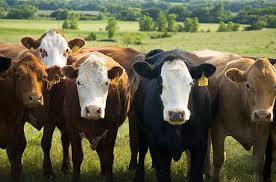With our mobile laboratories and haul-in facility, we are a full service embryo transfer business capable of meeting all your needs.
Embryo Transfer (ET) is a very advantageous reproductive technology for accelerating genetic gain in your herd. The term ET, as a whole, encompasses the production, collection, transfer, and/or freezing of embryos produced by a donor animal. The technology has been used commercially since the late 1970's and has made vast advancements in efficiency and effectiveness since its inception.
The whole process begins by selecting your most genetically superior females from the herd to utilize as donor animals. After selection, the donor will be placed on an estrus synchronization protocol that utilizes various hormones to stimulate the production of multiple dominant follicles for ovulation (superovulation). In a normal estrous cycle, a cow will generally only ovulate 1 dominant follicle available for fertilization every 21 days. This synchronization protocol allows for the donor to ovulate numerous follicles to be fertilized that will later be collected from the donors' uterus.
The whole process begins by selecting your most genetically superior females from the herd to utilize as donor animals. After selection, the donor will be placed on an estrus synchronization protocol that utilizes various hormones to stimulate the production of multiple dominant follicles for ovulation (superovulation). In a normal estrous cycle, a cow will generally only ovulate 1 dominant follicle available for fertilization every 21 days. This synchronization protocol allows for the donor to ovulate numerous follicles to be fertilized that will later be collected from the donors' uterus.
|
Conventional Embryo Transfer
|
In-Vitro FertilizationReproductive Ultrasound
Donor Boarding
|
Ashby Genetics provides clients with all schedules and medications for the synchronization protocol of each donor. As described above, donors are placed on a 16 day estrus synchronization protocol to stimulate the ovulation of multiple follicles for fertilization. The client is responsible for administering all drugs to donors along with inseminating the donor at the appropriate time she exhibits a heat. (Donor boarding is available. SEE BELOW)
A week after insemination, we will arrive on farm to collect (“flush”) the donor. This process involves passing a catheter through the cervix (similarly as what's done with AI) and inflating a small balloon at the catheter's tip to seat it within the uterus. Fluid is then infused into the uterus and recovered into a filter with the embryos for later processing. This is done multiple times to ensure all embryos are recovered. All embryos recovered are then assessed for quality and viability. Non-viable embryos are discarded, while better quality embryos are either transferred into recipient animals, or frozen in liquid nitrogen for future use. Typically donors can be collected conventionally every 35 days. Average number of viable embryos per collection is 8, but ranges from 0 to 60+. This process has many more working parts compared to conventional embryo production. It involves a similar synchronization protocol in that multiple follicles are stimulated. However, prior to normal ovulation of the follicles, we use an ultrasound-guided follicular aspiration technique called ovum pick-up (OPU) to collect the un-ovulated oocytes for future fertilization. The oocytes are then placed in an incubator that mimics the cows uterine environment while being shipped to the In-Vitro Fertilization (IVF) laboratory for fertilization 20-24 hours later. IVF produced embryos are ready to be implanted fresh or frozen for future use 8 days after the aspiration event.
Average number of viable embryos per collection - 6, but ranges from 0 to 60+ Availability of commercial IVF labs has allowed for Ashby Genetics to partner with Trans Ova Genetics to accept and fertilize oocytes for us in their lab. Along with this, we also have access to Trans Ova recipient animals located in Iowa and Texas where clients can have their embryos transferred at these locations and they purchase back the pregnant recipient after confirmed pregnant at 60 days. There are certain aspects of IVF that make it a viable option for a donor. Benefits include:
However, due to IVF lab costs, live calf costs are on average 2-2.5x more expensive than with conventional embryo transfer. There are other downsides to IVF embryo production compared to conventional. Please refer to our conventional vs. IVF comparison below and contact us directly to discuss whether IVF is a good option for you. Use of reproductive ultrasound has allowed for early and accurate pregnancy diagnosis as low as 26 days of age. This allows for adequate resynchronization of recipient animals to maximize their use.
When the fetus reaches a certain age, we are able to determine the sex of the fetus. Ability to do this ranges from 60-95 days pregnant. As the fetus continues to grow beyond 95 days, the fetus begins to fall over the brim of the pelvis and fetal sexing cannot be done.
Dr. Dan Hadacek and his wife Dr. Sarah Whitman (both veterinarians) operate a donor boarding facility at their farm located within 20 minutes of our clinic in Mount Solon, VA. They will house donors, monitor health, administer all estrus synchronization injections, and handle all heat detection and artificial insemination (AI) procedures. For more information contact Dr. Dan Hadacek at: (540) 820-3472. |
Conventional ET vs. IVF
Conventional ET
|
IVF
|





